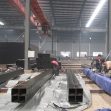How to choose your residential glass curtain wall system
Curtain wall system has become a distinctive feature of the modern buildings today. Like commercial curtain walls, residential curtain wall systems envelope buildings in non-structural glass and aluminum facades that transfer loads and resistance to the building’s main structure. These glazing systems utilize thermally broken heavy duty glass panes for optimal heat efficiency in applications.

In the modern times, aluminium curtain walls have regarded an attractive modern-looking option for residential building exterior. Because of structural glass curtain wall’s ability to resist air and water infiltration, your residential buildings would be energy efficient in applications in future. This will reduce your cost of heating, cooling, and lighting the building. So in addition to saving you money on construction, it has long-term savings benefits. Another benefit of the structural glass curtain wall system is that it can be installed in small or large units, depending on the needs and preference in your project. The walls may span the distance of the floor to ceiling or be installed across multiple floors. This allows for a greater flexibility in design.
Today, more and more people prefer to retro-fit their home with a variety of residential curtain wall systems and glass partition walls. As a rule, a typical valuable engineering process is designed to achieve balance between the product function and the construction cost in projects. If you are smart about the environmental design of a glass curtain wall system in your residential application, you can potentially construct a home that will actually maximize natural heating and cooling by capturing the sun’s warmth or deflecting it. It’s not a one-size-fits-all formula. The type of passive heating and cooling features you choose depends a lot on your home’s regional climate. A green building service or architecture firm will know how to best adapt your home design for your area. For example, if winter heating forms the bulk of your energy expenses, a south-facing wall helps you maximize solar heat throughout the day. South-facing walls tend to absorb the most heat due to their position so that they receive the sun’s light at a more direct angle. That solar heat filters into your home’s interiors, which can potentially help offset some of your heating needs.
In addition, a good maintenance plan should include routine inspection, regular cleaning, prompt repair of minor problems, and written records of maintenance activity to keep you on track. If you would like to reduce your curtain wall cost for a regular maintenance in the long run, you should consider a proactive, and ongoing maintenance plan in advance because it can help you reduce the risk of those bigger headaches.
Tel: +86 18202256900 Email: steel@fwssteel.com










